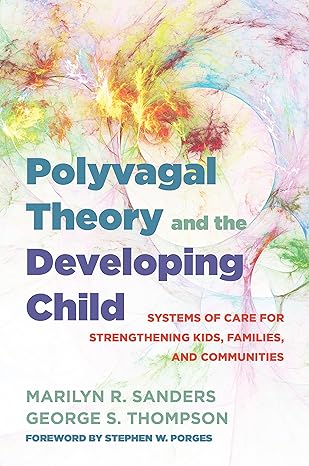polyvagal理论与儿童发展:加强儿童、家庭和社区的照顾系统

How sustained disruptions to children’s safety have physical, behavioral, and mental health impact that follow them into adulthood.
At its heart, polyvagal theory describes how the brain’s unconscious sense of safety or danger impacts our emotions and behaviors. In this powerful book, pediatrician and neonatologist Marilyn R. Sanders and child psychiatrist George S. Thompson offer readers both a meditation on caregiving and a call to action for physicians, educators, and mental health providers. When children don’t have safe relationships, or emotional, medical, or physical traumas punctuate their lives, their ability to love, trust, and thrive is damaged. Children who have multiple relationship disruptions may have physical, behavioral, or mental health concerns that follow them into adulthood.
By attending to the lessons of polyvagal theory―that adult caregivers must be aware of children’s unconscious processing of sensory information―the authors show how professionals can play a critical role in establishing a sense of safety even in the face of dangerous, and sometimes incomprehensibly scary, situations.
25 black-and-white illustrations
持续的儿童安全中断对他们的身心健康产生影响,这些影响会伴随他们进入成年期。 在这一强有力的著作中,儿科医生和新生儿科医生玛琳·R·桑德斯以及儿童精神科医生乔治·S·汤普森为读者提供了一次关于养育方式的冥想,并呼吁医生、教育者和心理健康专业人员采取行动。当孩子们没有安全关系,或情感、医疗或身体创伤贯穿他们生活时,他们的爱、信任和茁壮成长的能力就会受损。经历多次人际关系中断的孩子可能会在成年期出现身体、行为或精神健康问题。 通过关注多巴腔理论的教训——即成人照顾者必须意识到儿童对感官信息的无意识处理——作者展示了专业人士如何能够在危险甚至有时难以理解的可怕情况下,仍能发挥关键作用来建立一种安全感。
本站不对文件进行储存,仅提供文件链接,请自行下载,本站不对文件内容负责,请自行判断文件是否安全,如发现文件有侵权行为,请联系管理员删除。
Wireless Communications for Power Substations: RF Characterization and Modeling
Projective Geometry: Solved Problems and Theory Review (True PDF,EPUB)
Kingship and Government in Pre-Conquest England c.500–1066
Numerical Algorithms with C
Mathematical Modelling Skills
The Art of Encouragement: How to Lead Teams, Spread Love, and Serve from the Heart (True PDF)
Principles of Cybersecurity
React in Depth (True/Retail EPUB)
The Complete Obsolete Guide to Generative AI (True/Retail EPUB)
IT-Forensik: Ein Grundkurs